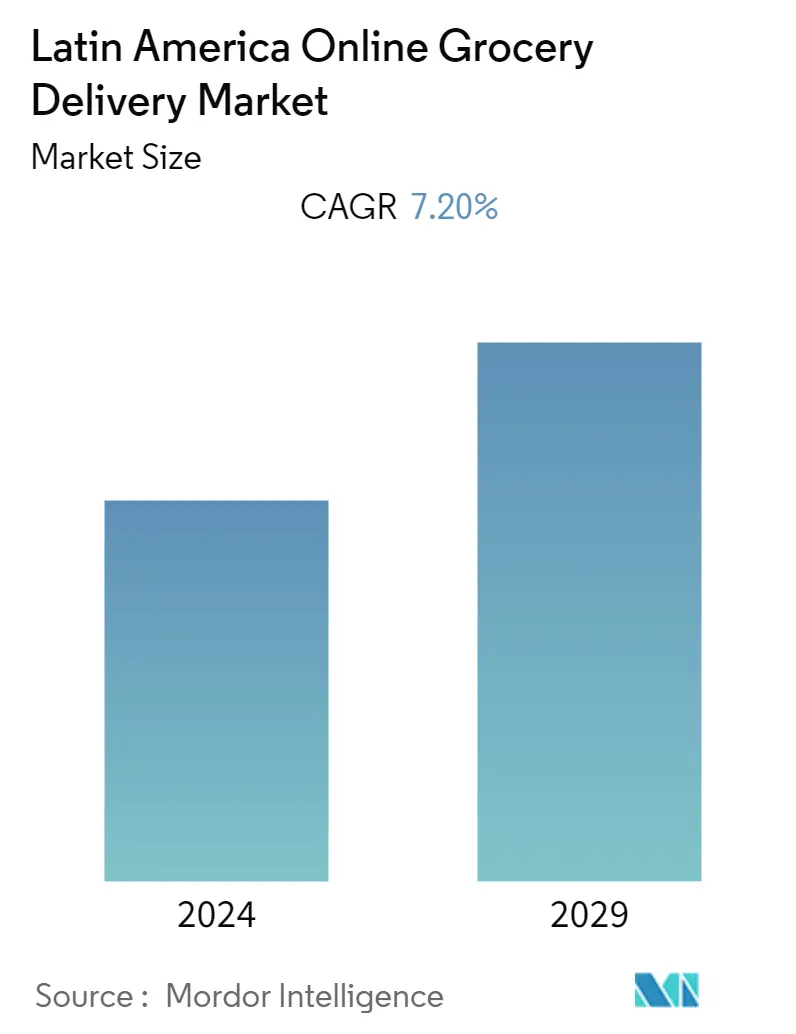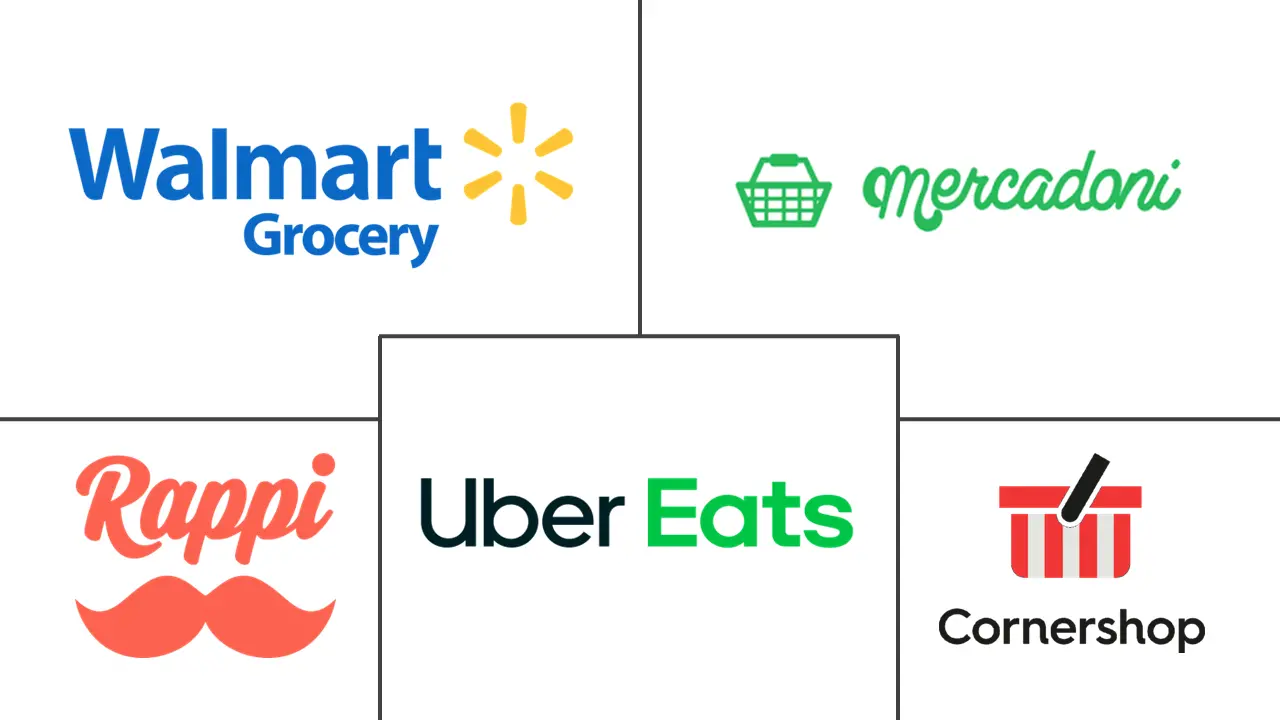Market Size of Latin America Online Grocery Delivery Industry

| Study Period | 2019 - 2029 |
| Base Year For Estimation | 2023 |
| Forecast Data Period | 2024 - 2029 |
| Historical Data Period | 2019 - 2022 |
| CAGR | 7.20 % |
| Market Concentration | Medium |
Major Players
*Disclaimer: Major Players sorted in no particular order |
Latin America Online Grocery Delivery Market Analysis
The Latin American online grocery delivery market is expected to register a CAGR of 7.2% over the forecasted period. The Latin American market is also pushed by the vast array of food items and cuisines available at the customer's doorstep, allowing them to sample a range of delicacies. These services assist service providers in extracting precise client information in order to improve their experience through the development and implementation of promotional tactics. The online meal delivery market is also affected by how busy people are and how more people live in cities, which makes people like to use the service.
- Online grocery ordering has become increasingly popular in recent years. One of the primary drivers of market growth is the increasing proliferation of smartphones and internet connections, which allow for very easy and speedy meal delivery. According to GSMA Intelligence, the number of mobile customers in Latin America will reach over 450 million by the end of 2021, rising to 485 million by 2025.
- Demand fluctuations in online delivery are frequently unpredictable and severe. As a result, managing delivery executives and devising tactics to increase delivery profitability becomes tough. Savvy restaurants are embracing crowdsourcing technologies to accommodate flexible food delivery demands. Crowdsourcing enables food establishments to outsource deliveries to temporary and part-time delivery executives based on costs, productivity, client proximity, and other factors. Crowdsourcing is quickly gaining popularity as a smart strategy to ensure delivery scalability and reduce expenses.
- The popularity of virtual assistants is growing as new and innovative capabilities are added regularly. Like Twitter, Domino's quickly recognized an opportunity and capitalized on it by creating their pizza bot, Dom. This bot may take orders, notify clients about vouchers, and share their most recent bargains. For example, GrubHub, an online food ordering company, integrates with Alexa, Amazon's smart assistant. Customers can order from any of their previous three transactions. When a customer tells Alexa what they want to order, the action is performed, and the anticipated delivery time is announced.
- The COVID-19 outbreak particularly heavily struck the grocery service industry. Many Latin American countries went into lockdown to try to contain the spread. In this scenario, meal delivery became the only way for grocery service firms to stay open during the pandemic. However, stricter safety and hygiene regulations have compelled delivery companies to use contactless delivery. Operators in Brazil, for example, are looking into meal kits and ready meals to increase their services. To address the rising demand for pampering and convenience, supermarket chain Pao de Acucar's Cheftime Restaurant prepares meals in the supermarkets' idle kitchens and deli stations.
- As grocery delivery services grow in popularity, they face a regulatory issue. Currently, delivery personnel who use these new apps are not formally hired. Grocery tech firms' business models rely on independent delivery workers who pick when and how many deliveries to accept. This has created uncertainties about labor standards in most LATAM countries, with some enterprises even being suspended. Online grocery delivery companies must ensure that their work policies are legal while also contributing to the creation of new jobs and the growth of local economies.
Latin America Online Grocery Delivery Industry Segmentation
An online grocery is either a physical supermarket or grocery store that accepts online orders or a separate e-commerce operation that sells grocery items. This service normally comes with a delivery fee. Online grocers are traditional supermarkets that have created internet channels to serve their customers better.
The Latin America Online Grocery Delivery Market is segmented by product type ( Retail Delivery, Quick Commerce, Meal Kit Delivery) and by Geography (Brazil, Mexico, Argentina, and Rest of Latin America).
The market sizes and forecasts are provided in terms of value (USD million) for all the above segments.
| By Product Type | |
| Retail Delivery | |
| Quick Commerce | |
| Meal Kit Delivery |
| By Region | |
| Brazil | |
| Mexico | |
| Argentina | |
| Rest of Latin America |
Latin America Online Grocery Delivery Market Size Summary
The Latin American online grocery delivery market is experiencing significant growth, driven by the increasing urbanization and the proliferation of smartphones and internet connectivity. These factors have made online grocery ordering more accessible and appealing to consumers, who are drawn to the convenience of having a diverse range of food items delivered to their doorstep. The market is also benefiting from the busy lifestyles of urban dwellers, who prefer the ease of online services. However, the market faces challenges such as demand fluctuations and the need for effective management of delivery personnel. Companies are leveraging crowdsourcing technologies to enhance delivery scalability and reduce costs, while also integrating innovative solutions like virtual assistants to streamline the ordering process.
The competitive landscape of the Latin American online grocery delivery market is characterized by the presence of multiple players who are actively engaging in product innovation, mergers, and acquisitions to expand their reach and maintain competitiveness. The market is also witnessing a shift towards in-house delivery management systems, as grocery retailers seek to regain control over the delivery process and ensure a consistent customer experience. Investments in cloud and dark kitchens are further propelling market growth, with companies like Mimic attracting significant funding to expand their operations. As the market continues to evolve, players are increasingly focusing on leveraging customer data to enhance efficiency and improve the overall consumer experience, positioning themselves for sustained growth in the coming years.
Latin America Online Grocery Delivery Market Size - Table of Contents
-
1. MARKET INSIGHTS
-
1.1 Market Overview
-
1.2 Industry Attractiveness - Porter's Five Forces Analysis
-
1.2.1 Bargaining Power of Suppliers
-
1.2.2 Bargaining Power of Consumers
-
1.2.3 Threat of New Entrants
-
1.2.4 Threat of Substitute Products
-
1.2.5 Intensity of Competitive Rivalry
-
-
1.3 Impact of COVID-19 on the Market
-
-
2. MARKET SEGMENTATION
-
2.1 By Product Type
-
2.1.1 Retail Delivery
-
2.1.2 Quick Commerce
-
2.1.3 Meal Kit Delivery
-
-
2.2 By Region
-
2.2.1 Brazil
-
2.2.2 Mexico
-
2.2.3 Argentina
-
2.2.4 Rest of Latin America
-
-
Latin America Online Grocery Delivery Market Size FAQs
What is the current Latin America Online Grocery Delivery Market size?
The Latin America Online Grocery Delivery Market is projected to register a CAGR of 7.20% during the forecast period (2024-2029)
Who are the key players in Latin America Online Grocery Delivery Market?
Walmart Grocery, Uber Eats, Cornershop, Mercadoni and Rappi are the major companies operating in the Latin America Online Grocery Delivery Market.

